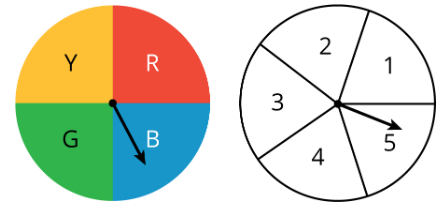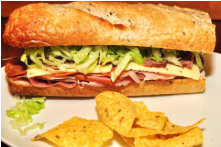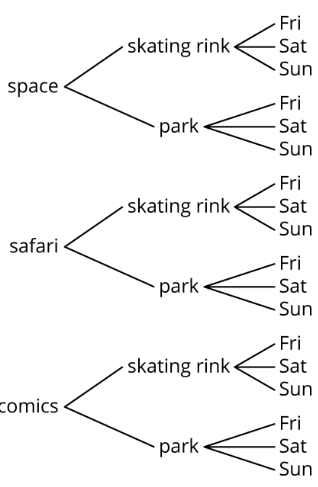8.2.2: Keeping Track of All Possible Outcomes
- Page ID
- 39023
\( \newcommand{\vecs}[1]{\overset { \scriptstyle \rightharpoonup} {\mathbf{#1}} } \)
\( \newcommand{\vecd}[1]{\overset{-\!-\!\rightharpoonup}{\vphantom{a}\smash {#1}}} \)
\( \newcommand{\id}{\mathrm{id}}\) \( \newcommand{\Span}{\mathrm{span}}\)
( \newcommand{\kernel}{\mathrm{null}\,}\) \( \newcommand{\range}{\mathrm{range}\,}\)
\( \newcommand{\RealPart}{\mathrm{Re}}\) \( \newcommand{\ImaginaryPart}{\mathrm{Im}}\)
\( \newcommand{\Argument}{\mathrm{Arg}}\) \( \newcommand{\norm}[1]{\| #1 \|}\)
\( \newcommand{\inner}[2]{\langle #1, #2 \rangle}\)
\( \newcommand{\Span}{\mathrm{span}}\)
\( \newcommand{\id}{\mathrm{id}}\)
\( \newcommand{\Span}{\mathrm{span}}\)
\( \newcommand{\kernel}{\mathrm{null}\,}\)
\( \newcommand{\range}{\mathrm{range}\,}\)
\( \newcommand{\RealPart}{\mathrm{Re}}\)
\( \newcommand{\ImaginaryPart}{\mathrm{Im}}\)
\( \newcommand{\Argument}{\mathrm{Arg}}\)
\( \newcommand{\norm}[1]{\| #1 \|}\)
\( \newcommand{\inner}[2]{\langle #1, #2 \rangle}\)
\( \newcommand{\Span}{\mathrm{span}}\) \( \newcommand{\AA}{\unicode[.8,0]{x212B}}\)
\( \newcommand{\vectorA}[1]{\vec{#1}} % arrow\)
\( \newcommand{\vectorAt}[1]{\vec{\text{#1}}} % arrow\)
\( \newcommand{\vectorB}[1]{\overset { \scriptstyle \rightharpoonup} {\mathbf{#1}} } \)
\( \newcommand{\vectorC}[1]{\textbf{#1}} \)
\( \newcommand{\vectorD}[1]{\overrightarrow{#1}} \)
\( \newcommand{\vectorDt}[1]{\overrightarrow{\text{#1}}} \)
\( \newcommand{\vectE}[1]{\overset{-\!-\!\rightharpoonup}{\vphantom{a}\smash{\mathbf {#1}}}} \)
\( \newcommand{\vecs}[1]{\overset { \scriptstyle \rightharpoonup} {\mathbf{#1}} } \)
\( \newcommand{\vecd}[1]{\overset{-\!-\!\rightharpoonup}{\vphantom{a}\smash {#1}}} \)
\(\newcommand{\avec}{\mathbf a}\) \(\newcommand{\bvec}{\mathbf b}\) \(\newcommand{\cvec}{\mathbf c}\) \(\newcommand{\dvec}{\mathbf d}\) \(\newcommand{\dtil}{\widetilde{\mathbf d}}\) \(\newcommand{\evec}{\mathbf e}\) \(\newcommand{\fvec}{\mathbf f}\) \(\newcommand{\nvec}{\mathbf n}\) \(\newcommand{\pvec}{\mathbf p}\) \(\newcommand{\qvec}{\mathbf q}\) \(\newcommand{\svec}{\mathbf s}\) \(\newcommand{\tvec}{\mathbf t}\) \(\newcommand{\uvec}{\mathbf u}\) \(\newcommand{\vvec}{\mathbf v}\) \(\newcommand{\wvec}{\mathbf w}\) \(\newcommand{\xvec}{\mathbf x}\) \(\newcommand{\yvec}{\mathbf y}\) \(\newcommand{\zvec}{\mathbf z}\) \(\newcommand{\rvec}{\mathbf r}\) \(\newcommand{\mvec}{\mathbf m}\) \(\newcommand{\zerovec}{\mathbf 0}\) \(\newcommand{\onevec}{\mathbf 1}\) \(\newcommand{\real}{\mathbb R}\) \(\newcommand{\twovec}[2]{\left[\begin{array}{r}#1 \\ #2 \end{array}\right]}\) \(\newcommand{\ctwovec}[2]{\left[\begin{array}{c}#1 \\ #2 \end{array}\right]}\) \(\newcommand{\threevec}[3]{\left[\begin{array}{r}#1 \\ #2 \\ #3 \end{array}\right]}\) \(\newcommand{\cthreevec}[3]{\left[\begin{array}{c}#1 \\ #2 \\ #3 \end{array}\right]}\) \(\newcommand{\fourvec}[4]{\left[\begin{array}{r}#1 \\ #2 \\ #3 \\ #4 \end{array}\right]}\) \(\newcommand{\cfourvec}[4]{\left[\begin{array}{c}#1 \\ #2 \\ #3 \\ #4 \end{array}\right]}\) \(\newcommand{\fivevec}[5]{\left[\begin{array}{r}#1 \\ #2 \\ #3 \\ #4 \\ #5 \\ \end{array}\right]}\) \(\newcommand{\cfivevec}[5]{\left[\begin{array}{c}#1 \\ #2 \\ #3 \\ #4 \\ #5 \\ \end{array}\right]}\) \(\newcommand{\mattwo}[4]{\left[\begin{array}{rr}#1 \amp #2 \\ #3 \amp #4 \\ \end{array}\right]}\) \(\newcommand{\laspan}[1]{\text{Span}\{#1\}}\) \(\newcommand{\bcal}{\cal B}\) \(\newcommand{\ccal}{\cal C}\) \(\newcommand{\scal}{\cal S}\) \(\newcommand{\wcal}{\cal W}\) \(\newcommand{\ecal}{\cal E}\) \(\newcommand{\coords}[2]{\left\{#1\right\}_{#2}}\) \(\newcommand{\gray}[1]{\color{gray}{#1}}\) \(\newcommand{\lgray}[1]{\color{lightgray}{#1}}\) \(\newcommand{\rank}{\operatorname{rank}}\) \(\newcommand{\row}{\text{Row}}\) \(\newcommand{\col}{\text{Col}}\) \(\renewcommand{\row}{\text{Row}}\) \(\newcommand{\nul}{\text{Nul}}\) \(\newcommand{\var}{\text{Var}}\) \(\newcommand{\corr}{\text{corr}}\) \(\newcommand{\len}[1]{\left|#1\right|}\) \(\newcommand{\bbar}{\overline{\bvec}}\) \(\newcommand{\bhat}{\widehat{\bvec}}\) \(\newcommand{\bperp}{\bvec^\perp}\) \(\newcommand{\xhat}{\widehat{\xvec}}\) \(\newcommand{\vhat}{\widehat{\vvec}}\) \(\newcommand{\uhat}{\widehat{\uvec}}\) \(\newcommand{\what}{\widehat{\wvec}}\) \(\newcommand{\Sighat}{\widehat{\Sigma}}\) \(\newcommand{\lt}{<}\) \(\newcommand{\gt}{>}\) \(\newcommand{\amp}{&}\) \(\definecolor{fillinmathshade}{gray}{0.9}\)Lesson
Lets explore sample spaces for experiments with multiple parts.
Exercise \(\PageIndex{1}\): How Many Different Meals?
How many different meals are possible if each meal includes one main course, one side dish, and one drink?
| main courses | side dishes | drinks |
|---|---|---|
| grilled chicken | salad | milk |
| turkey sandwich | applesauce | juice |
| pasta salad | \(\underline{\quad}\) | water |
Exercise \(\PageIndex{2}\): Lists, Tables, and Trees
Consider the experiment: Flip a coin, and then roll a number cube.
Elena, Kiran, and Priya each use a different method for finding the sample space of this experiment.
- Elena carefully writes a list of all the options: Heads 1, Heads 2, Heads 3, Heads 4, Heads 5, Heads 6, Tails 1, Tails 2, Tails 3, Tails 4, Tails 5, Tails 6.
- Kiran makes a table:
1 2 3 4 5 6 H H1 H2 H3 H4 H5 H6 T T1 T2 T3 T4 T5 T6 Table \(\PageIndex{2}\) - Priya draws a tree with branches in which each pathway represents a different outcome:

- Compare the three methods. What is the same about each method? What is different? Be prepared to explain why each method produces all the different outcomes without repeating any.
- Which method do you prefer for this situation?
Pause here so your teacher can review your work. - Find the sample space for each of these experiments using any method. Make sure you list every possible outcome without repeating any.
- Flip a dime, then flip a nickel, and then flip a penny. Record whether each lands heads or tails up.
- Han’s closet has: a blue shirt, a gray shirt, a white shirt, blue pants, khaki pants, and black pants. He must select one shirt and one pair of pants to wear for the day.
- Spin a color, and then spin a number.

d. Spin the hour hand on an analog clock, and then choose a.m. or p.m.
Exercise \(\PageIndex{3}\): How Many Sandwiches?
1. A submarine sandwich shop makes sandwiches with one kind of bread, one protein, one choice of cheese, and two vegetables. How many different sandwiches are possible? Explain your reasoning. You do not need to write out the sample space.
- Breads: Italian, white, wheat
- Proteins: Tuna, ham, turkey, beans
- Cheese: Provolone, Swiss, American, none
- Vegetables: Lettuce, tomatoes, peppers, onions, pickles

2. Andre knows he wants a sandwich that has ham, lettuce, and tomatoes on it. He doesn’t care about the type of bread or cheese. How many of the different sandwiches would make Andre happy?
3. If a sandwich is made by randomly choosing each of the options, what is the probability it will be a sandwich that Andre would be happy with?
Are you ready for more?
Describe a situation that involves three parts and has a total of 24 outcomes in the sample space.
Summary
Sometimes we need a systematic way to count the number of outcomes that are possible in a given situation. For example, suppose there are 3 people (A, B, and C) who want to run for the president of a club and 4 different people (1, 2, 3, and 4) who want to run for vice president of the club. We can use a tree, a table, or an ordered list to count how many different combinations are possible for a president to be paired with a vice president.
With a tree, we can start with a branch for each of the people who want to be president. Then for each possible president, we add a branch for each possible vice president, for a total of \(3\cdot 4=12\) possible pairs. We can also start by counting vice presidents first and then adding a branch for each possible president, for a total of \(3\cdot 4=12\) possible pairs.

A table can show the same result:
| 1 | 2 | 3 | 4 | |
|---|---|---|---|---|
| A | \(A, 1\) | \(A, 2\) | \(A, 3\) | \(A, 4\) |
| B | \(B, 1\) | \(B, 2\) | \(B, 3\) | \(B, 4\) |
| C | \(C, 1\) | \(C, 2\) | \(C, 3\) | \(C, 4\) |
So does this ordered list:
A1, A2, A3, A4, B1, B2, B3, B4, C1, C2, C3, C4
Practice
Exercise \(\PageIndex{4}\)
Noah is planning his birthday party. Here is a tree showing all of the possible themes, locations, and days of the week that Noah is considering.
- How many themes is Noah considering?
- How many locations is Noah considering?
- How many days of the week is Noah considering?
- One possibility that Noah is considering is a party with a space theme at the skating rink on Sunday. Write two other possible parties Noah is considering.
- How many different possible outcomes are in the sample space?

Exercise \(\PageIndex{5}\)
For each event, write the sample space and tell how many outcomes there are.
- Lin selects one type of lettuce and one dressing to make a salad.
Lettuce types: iceberg, romaine
Dressings: ranch, Italian, French - Diego chooses rock, paper, or scissors, and Jada chooses rock, paper, or scissors.
- Spin these 3 spinners.

Exercise \(\PageIndex{6}\)
A simulation is done to represent kicking 5 field goals in a single game with a 72% probability of making each one. A 1 represents making the kick and a 0 represents missing the kick.
| trial | result |
|---|---|
| 1 | 10101 |
| 2 | 11010 |
| 3 | 00011 |
| 4 | 11111 |
| 5 | 10011 |
(From Unit 8.2.1)
Exercise \(\PageIndex{7}\)
There is a bag of 50 marbles.
- Andre takes out a marble, records its color, and puts it back in. In 4 trials, he gets a green marble 1 time.
- Jada takes out a marble, records its color, and puts it back in. In 12 trials, she gets a green marble 5 times.
- Noah takes out a marble, records its color, and puts it back in. In 9 trials, he gets a green marble 3 times.
Estimate the probability of getting a green marble from this bag. Explain your reasoning.
(From Unit 8.1.4)


